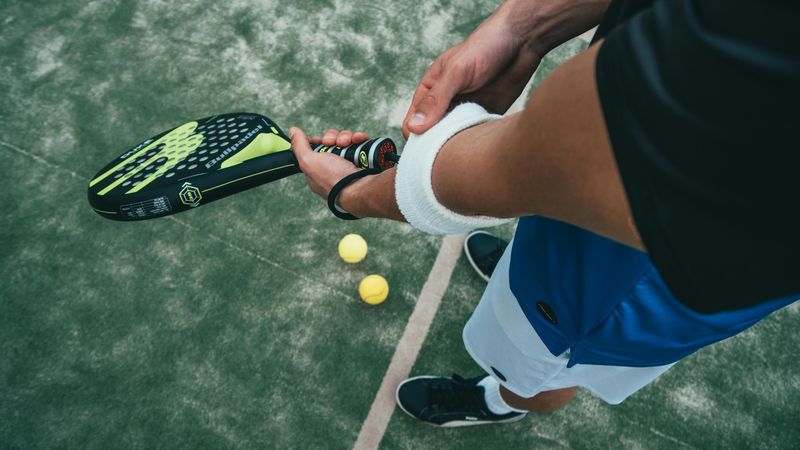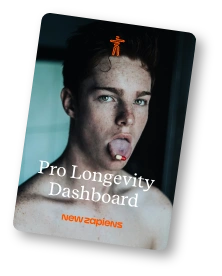When the Doctor Becomes the Patient — A personal story about circulating tumor cells, radical cancer screening and learning to live with uncertainty.

I’m about to do something I’ve never done in writing before. Share something deeply personal.
What you are about to read is my experience with aggressive cancer screening. My rational strategies. My emotional roller coaster ride. My story.
But first a bit of background.
Hi there.
You might not know me yet. My name is Johan Hedevåg. I’m a longevity physician and health tech entrepreneur based in Stockholm, where I run Revi Health. Our clinic focuses on stemcells, metabolic & hormonal health and the art of longevity. Why is this relevant?
You’re about to find out.
Just another day?
This story starts on a normal day in April. Ever-changing weather, not unlike most other April days. Little did I know, it would be the beginning of a very special journey. One of hope and despair. Of beauty and cancer.
I was evaluating different offerings to include in our ultra high end health check.
I had already settled on:
- Extensive blood work
- Dexa scan
- Full-body MRI
- Performance tests including grip strength and VO²max
- Ultrasound of all joints
- Colonoscopy
- CT-angiogram
- Full physical with doctor
Next on the list of things to evaluate? Liquid biopsy.
For those unfamiliar, let’s take a quick detour.
What are liquid biopsies?
A liquid biopsy is a simple blood draw, aiming to detect signs of early stage cancer.
These tests don’t diagnose cancer. But they may detect signs that warrant further investigation — sometimes years before a tumor becomes visible.
There are a few technologies available in this space. The main ones look for:
- Circulating Tumor Cells, CTC.
- Most tissue release cells into the blood stream, called circulating cells.
- This technology identifies circulating cells that resist apoptosis — our body’s way of clearing abnormal cells. That resistance is a red flag. These are very likely circulating tumor cells.
- Next, it dyes the cell surface and looks for specific markers (e.g. EpCAM, PanCK or CD45-) to identify the type of cell and its origin. Is it perhaps an epithelial cell or a mesenchymal cell?
- Circulating Tumor DNA, ctDNA.
- Stressed or dying cells release DNA into the blood stream. This is called cell free DNA, cfDNA.
- This technology detects cfDNA with mutated genes, known to be associated with cancer tumours. These snippets of DNA are called ctDNA.
- If DNA with a specific mutation is found, its origin can then be determined based on a large database of known mutations. Does it come from the Lungs or from the Pancreas?
Moral of the quick detour? Neither technology is perfect but both are very promising.
Back to the story.
I had decided to evaluate one CTC test, called Trucheck, and one combined CTC and ctDNA test called Trublood. Both tests provided by Datar Cancer Genetics.
A patient of mine, who had previously undergone Prostate cancer, asked me to take the Trublood test to see if ctDNA was present (can indicate a higher risk of cancer recurrence). I said yes.
The Trucheck test, I took on myself.
The process was smooth, both tests were sent to the UK for analysis and I went on to focus on other things.
A couple of weeks passed by.
A mixed bag of unpleasant feelings.
May 12th, 9.53 pm.
I was sitting in my living room couch, finishing up some work. I was tired. Bed time was imminent. Just one more email to go through…
“Ah, from Datar Cancer Genetics, great.”
I clicked on the attached PDF with my name on it, unlocked with the encryption key and started reading. Something caught my eye right away.
☑ Circulating Tumor Cells (CTCs) detected, indicating higher risk of presence of cancer.
“Wait a minute. That can’t be right.”
My head started spinning. It was my first time reading a report like this, was I missing something. I continued to read.
☑ Probability of Carcinoma.☑ Organ of origin could not be determined.
“What the hell is going on? Clearly this must be a mistake.”
My rational mind kicked in. Deep breath. Double and triple check!
“Okay. It does say CTCs detected. What’s the plan?”
- Is it possible that the results got mixed up somehow?
- Can it be a false positive?
Another deep breath. Let’s think this through.
“My blood was shipped in the same cooling box as my patient’s. Room for error! Although, I did attach the labels on the test tubes myself and I’m 100% sure I didn’t mess that up. Still, I need to speak to the lab about it.”
Keep breathing. Keep thinking.
“Trucheck covers 80% of all solid tumours with a specificity of 96-99%. What hides in the missing percentages? What about the specificity for cells with the same markers as mine?”

I'm analysing the results of a liquid biopsy. What's EpCAM and PanCK?
Long answer. I focused.
Keep reading. Keep processing.
“They are surface proteins of epithelial cells. Got it. Remember to breathe.”
Does this specific staining impact the overall specificity in any direction?
Short answer.
“If anything, it means that the specificity is higher.”
I stopped breathing.
🧠 Realisation 1: It’s very, very likely that I have a cancer tumour.
I started breathing again. It was time to become a rational agent.
“What’s the plan Johan? What’s the plan?”
This is the plan.
I held my breath for most of the time when coming up with it.
- Phase 1: Understand possible tumour origins.
- Phase 2: Set up a diagnostic protocol.
- Phase 3: Identify and implement strategies to:
- Do things that surpress tumour growth
- Avoid things that promote tumour growth
- Do things that promote general health
- Avoid things harmful to general health
Phase 1: Possible tumour origins.
I continued my chatGPT dialogue.
If these markers are positive, what are the likely origins of the tumor?
A structured answer.
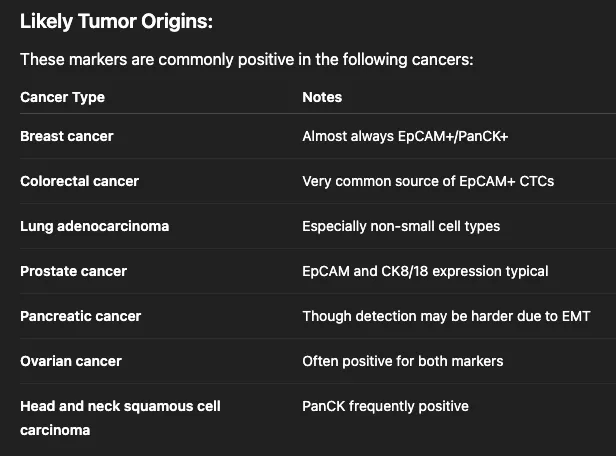
I then went through my cancer heredity.
- Father: Malignant melanoma in his 60s. Survived.
- Mother: No known cancer.
- Grandfather on father's side: Prostate cancer at the time of death in his early 70s.
- Grandmother on father's side: Died of Pancreas cancer in her 50s.
- Uncle on father's side: No known cancer.
- Grandfather on mother's side: Died of lung cancer in his late 60s.
- Grandmother on mother's side: Breast cancer in her 60s. Survived.
- Uncle on mother's side: Colon cancer in his early 60s. Survived.
That’s my entire blood related family (excluding my 2 children and my 4 cousins)
“Not a pretty list.”
🧠 Realisation 2: Most of the plausible cancer types run in my family.
“That doesn’t matter. I’m a rational agent. Move on to the next phase 2.”
Phase 2: The diagnostic protocol.
I listened to myself and got to work.
- First step of a diagnostic protocol: Understand probability of origin.
- Second step: Cross run probability of origin with probability of death.
- Third step: Stack rank selected diagnostic procedures.
- Fourth step: Execute.
I created a first version of a weighted probability estimate of different cancer types. It was based on population prevalence, heredity and personal characteristics (age, gender, lifestyle, medical history etc.).
As before, I had the support of my beloved AI companion.
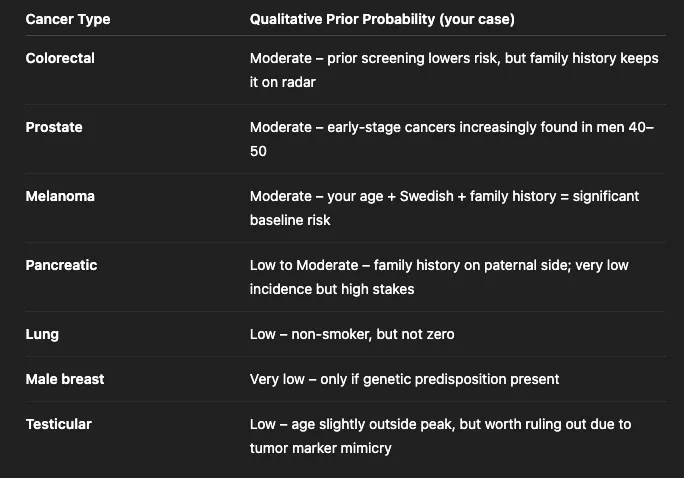
“I can do this. In fact, I’m in a unique position to do this. One of very few who can act on this information.”
Time to take action.
But first sleep.
I went to bed. It was late and my brain was fried. Didn’t think I would be able to sleep but I passed out within minutes.
Next morning.
“I slept better than expected. Good. Now execute.”
☑️ Action 1: Set up a call with the medical director of Datar Cancer Genetics.
☑️ Action 2: Send referral for extensive blood work.
☑️ Action 3: Book a dermatology exam.
☑️ Action 4: Schedule a colonoscopy.
☑️ Action 5: Send referrals for: Full-body MRI, Prostate MRI, Pancreas MRCP, CT Thorax, Testicular ultrasound.
All done before lunch. Now what?
“Do I just go on with life as normal? What about telling people? My wife? My parents? Surely I can’t tell my kids at this stage?”
Wait! Had forgotten about phase 3 of the plan? It was time to implement survival strategies.
I pushed away the difficult thoughts of communication and moved on.
Phase 3: Strategies to surpress tumour growth and optimise general health.
I was already living a very health life but it was time to optimise. I went high and low. Grasping for any straw with a limited downside and at least a theoretical upside.
Strategies
- Down regulate tumor growth (↓ proliferation, ↓ angiogenesis, ↓ mTOR, ↓ IGF-1)
- Starve tumor-supporting inputs (↓ glucose, ↓ growth factors, ↓ inflammation)
- Enhance immune function (↑ innate & adaptive response, ↑ NK cells, ↑ T cells)
- Boost systemic resilience (↑ mitochondria, ↓ inflammation, ↑ detox)
Tactics
- Diet
- Time-restricted eating (↓ insulin, ↓ IGF-1)
- 3 days of water fasting (↑ autophagy)
- Low-glycemic diet (↓ glucose, ↓ insulin/IGF-1)
- <100g carbs/day (starves glycolytic tumors)
- 1.5 - 2g protein (eggs, soybeans, chicken, whey, collagen, lentils) / kg / day.
- No alcohol (ethanol is carcinogenic and immunosuppressive)
- Avoid processed meat, charred foods, excess dairy (↓ IGF-1, ↓ inflammation)
- Broccoli sprouts, kale, arugula, cauliflower, cabbage (↑ detox)
- Garlic, onions, leeks, shallots (↓ inflammation, ↓ angiogenesis, immune-modulating)
- Polyphenol-rich berries & fruits (DNA-protective, ↓ oxidation, ↓ angiogenesis
- Fermented foods like kombucha & kimchi (↑ gut-immune axis)
- Pomegranate (↓ tumor growth and angiogenesis, ↑ apoptosis in cancer cells in vitro)
- Ginger (↓ inflammation)
- Exercise & Recovery
- Zone 2 + VO²max intervals (↑ NK cells, ↑ T-cells)
- Resistance training (↑ metabolic health, ↓ inflammation)
- Sleep optimisation (↑ T-cells, cytokine balance)
- Sauna (heat shock proteins, ↑ detox, immune modulation)
- Cold exposure (mitochondrial biogenesis, immune priming)
- Supplements
- Omega-3 (↓ pro-inflammatory omega-6, ↓ COX-2)
- Green tea extract (↓ VEGF, ↓ mTOR)
- Curcumin (↓ proliferation)
- Vitamin D3 (↑ immune regulation)
- Zinc (↑ T-cells)
- Magnesium glycinate (↓ inflammation, ↑ sleep, mitochondrial support)
- Creatine monohydrate (↑ muscle mass, ↑ cellular energy)
- Quercetin phytosome (senolytic, ↓ inflammation)
- Oral vitamin C (↓ oxidation)
- CoQ10 (↑ mitochondrial function)
- GlyNAC (↓ oxidation, redox balance, mitochondrial repair
- Taurine (↓ oxidation, ↑ mitochondrial function)
- Whey protein powder & collagen (support muscle mass)
- Psyllium husk (↑ gut-immune axis)
- 1-MNA (↓ inflammation, endothelial protective effects)
- TMG (may normalise DNA methylation)
- Pharmaceuticals
- Low dose Aspirin (↓ COX-1/2, ↓ platelet aggregation,↓ metastasis)
- Low dose Mounjaro (↑ insulin sensitivity, ↓ inflammation)
- Colchicine (↓ inflammation, may reduce metastasis and tumor growth)
- Future candidates
- Intravenous Vitamin C (pro-oxidant in tumor cells, generating hydrogen peroxide that selectively damages cancer cells)
This might seem like a very extensive protocol. Thankfully I didn’t have to change basically anything regarding diet, exercise and recovery. Just adding some supplements and pharmaceuticals.
24 hours had passed since I first read the results. My survival framework was done. It was time to think about communication.
Balancing transparency and protection of others.
“I don’t want to tell my wife yet. She’s already dealing with a lot, I don’t want her to have to live with the uncertainty. I’ll tell after the diagnostics are done. But, I need to tell someone or it might be too heavy of a burden.”
So, I decided to call a friend. A good friend who happens to be both rational and compassionate. He’s also a fellow physician.
Having someone to talk to was incredibly helpful and I’m very grateful for the unconditional support he gave me.
Ticking one box after another.
Things moved quickly from here.
✅ I had a call with the medical director of Datar Cancer Genetics. He basically confirmed my fears. The probability of a test mix up was abysmal, as was the probability of a false positive.
They had even run the test twice and gotten the same results. I have CTCs. Not tons of them but both tests clearly exceeded the threshold.
There might still be a tiny, tiny possibility that these cells don’t come from a tumour but rather from some rare, undiagnosed inflammatory condition. Unlikely but not impossible.
✅ My extensive blood work was basically normal. I did however have a S-CEA of 5. Right on the upper limit. This can be a sign of inflammation but it’s also a main marker used to track the progress of Colon cancer. Scary.
✅ The dermatologist didn’t see anything suspicious and the testicular ultrasound was normal.
With the new information at hand, I updated the probability matrix.
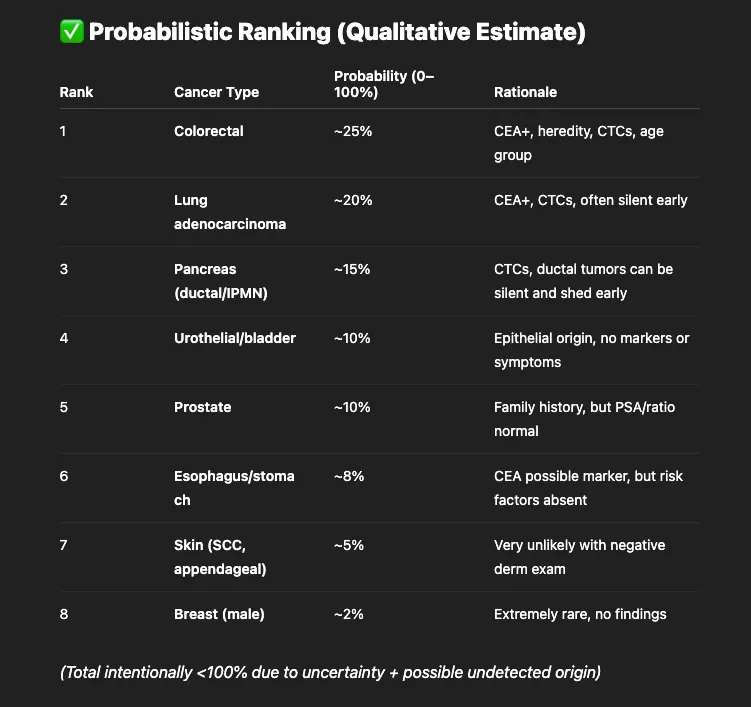
14 days had passed.
It was time for my colonoscopy. I was probably the first patient they’ve ever had who was hoping that they would find a tumor.
The 5 year survival for stage 1 Colon cancer is 91%. I’d take those odds.
The colonoscopy was normal. No colon cancer.
MRIs, MRCP and CT were scheduled 4 days later.
Friday May 30th. One day before my father’s birthday.
I spent 3 hours in the MRI and CT machines.
The answer from the CT Thorax and Prostate MRI arrived that very same afternoon.
No visible lung tumour. No signs of prostate cancer.
Bladder and Esophagus cancer felt highly unlikely due to lack of heredity, risk factors and symptoms.
Left on the list was pancreatic cancer.
The 5 year survival for stage 1 Pancreatic cancer is 30-50%. I don’t like those odds.
Friday evening and still no results.
Pain and beauty might just be neighbours.
The following weekend was emotional. My parents were visiting and we celebrated my dad’s birthday together.
My thoughts were all over the place.
“I don’t want pancreatic cancer. I want to see my kids grow up. I want to experience new things, generate new memories, learn new skills.”
The next minute.
“The world is so beautiful. I have lived an amazing life. More fortunate than most. As the wind is blowing in my hair, I wouldn’t want it any other way.”
I don’t think anyone noticed.
The reveal.
Lunch time Monday June 2nd.
I was standing by the computer in my home office. An email notification. The new test results had arrived. I once again stopped breathing.
I logged into the referral system.
“Breathe Johan. You gotta remember to breathe.”
I clicked on the result from the full-body MRI and Pancreas MRCP.
There are no suspicious findings for cancer or any other structural pathology.
I could breathe again. Feelings of relief. The confusion.
“So what's the verdict? What's the result? Do I have cancer or not?”
The honest answer?
I don't know.
- A false positive can’t be ruled out.
- The more likely explanation is that I have an extremely early tumour that may or may not materialise into active cancer.
Living with uncertainty.
Ironically, I have a lot more information now than prior to this situation. I know tons of things that I didn't know before.
Yet, my brain tells me that my life is more uncertain.
“I don’t know if I have cancer. I just know I have to live like I might. But wasn’t that always true?”
Where to go from here?
Well, the rational agent in me has created another screening protocol for the foreseeable future.

That’s as true for me as it is for you. As it is for everyone.
As certainly as constant is the only change, uncertainty is the only certainty.
References
Author: Johan Hedevåg
Longevity physician & healthtech builder. Co-founder and CEO of Revi Health. Focusing on orthobiologics, metabolic health, hormonal health & optimising performance.

